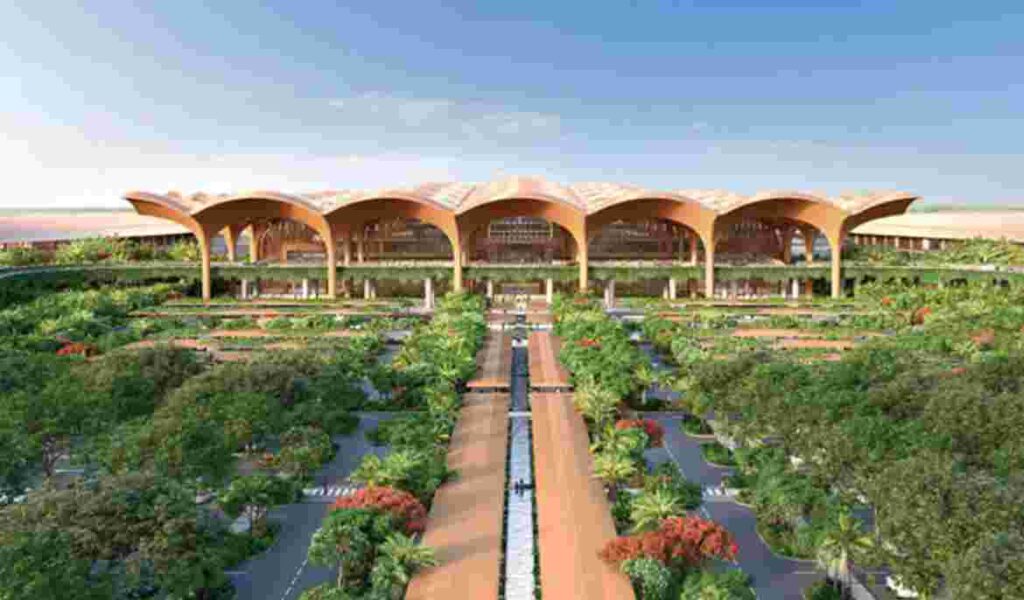The Techo Takhmao International Airport (TIA), which is now nearing construction completion in Kandal Province’s Takhmao district, is a large-scale airport development that might just transform Cambodia’s capital city, Phnom Penh, into the “new Singapore” of the region, observed an op-ed article published by UK-based media outlet the Daily Express.
The article published on October 20 has contended that similar to Singapore’s swift growth as a global logistics player linking East and West economies in years passed, Cambodia is set for a major renewal as a logistics hub for global trade and tourism following the completion of the new $1.2 billion TIA airport.
According to the report, TIA’s full operations promise to boost the economy to become a major player in the region, and propel the capital city’s growth to levels on par with its ASEAN neighbor Singapore.
TIA, which is located alongside Cambodia’s capital city, Phnom Penh, is set to become the ninth largest airport globally once operational in the first half of 2025, noted Daily Express.
Meanwhile, the report said that despite a history marred by civil wars, violence, and poverty, Cambodia remains a country bursting with natural beauty and a rich culture, as well as a snowballing economy.
The report cited that Cambodia is now the fastest-growing economy in Southeast Asia, and the third fastest in Asia overall.
Hence, the economy already demonstrates strong fundamentals for its continued expansion in coming decades.

The Daily Express compared the potential impact of TIA on the future Cambodian economy to major aviation investments in global trade and travel hubs such as Singapore and UAE’s Dubai.
Singapore’s world famous Changi Airport, located at the eastern edge of the city-state, was officially opened in December of 1981.
Today, Singapore Changi Airport hosts over 100 different airlines flying to destinations in Asia, Australia, Africa, Europe, the Middle East, and North America, and was an aviation hub that effectively transformed the country’s economic prospects, according to the Daily Express.
Similarly, the Dubai International Airport in UAE’s capital city, which first opened in 1960 following ten years of construction, created over 400,000 jobs and contributed more than $26 billion to the country’s economy.
The activities of the airport alone accounted for 27 percent of Dubai’s entire gross domestic product (GDP) in early years of operations, noted the report.
Meanwhile, following this historic success, the UAE has recently started construction on a new international airport entitled the Al Maktoum International Airport.
This new airport, once completed, is expected to be the world’s largest, and host a capacity of up to 260 million passengers annually.
According to the Daily Express, Phnom Penh city, by the development of TIA, is following in Singapore and Dubai’s footsteps.
“These cities used their airports as connectors between opposite sides of the globe. They boosted trade and increased tourism. Both things that are driving Cambodia’s economic resurgence,” the report stated.
The TIA project was announced in January 2018 and is being developed in three phases.
Phase one, which will be completed and open for business early 2025, will allow the airport to accommodate 13 to 15 million passengers and around 175,000 tonnes of cargo annually.
Being the highest class of airport recognised worldwide, TIA can accommodate large aircraft with extensive requirements such as runways over 3,000 meters in length, and is therefore suitable for the biggest passenger and cargo planes used in modern aviation.
Phase two will expand the airport significantly, adding a second wing to the terminal by 2030 and increasing annual passenger capacity to 30 million.
A third and final phase will see the airport grow to 50 million passengers by 2050, making it comparable to the roughly 42 million annual passengers of Singapore’s Changi Airport, said the Daily Express.
Furthermore, similar to Singapore’s Changi Airport, TIA is being designed and built to reflect Cambodia’s unique culture and architectural tastes as well as catering to reduced energy use and green building standards.
TIA has been uniquely designed so that the canopy resembles the jungles of Cambodia, noted the report.
“There are trunks that reach up and shield visitors from the sun with their branches. Instead of leaves, steel blossoms outward, forming a screen that filters the light,” it added.
The airport also references the country’s architectural style, such as the thatch roofs made from sugar palms.
The canopy borrows cooling techniques from these designs as well, using stacking techniques and gaps between the roof and walls, allowing hot air to be pushed out by incoming cool air.
By using these natural cooling techniques the airport will benefit from not having to rely as much on internal air conditioning, said the Daily Express.
Meanwhile, Singapore has also become a strong regional and global economy thanks to its extensive deep sea port infrastructure, making the country a key transit port for international sea bound trade as well as international cruise-line tourism.
In another article released this month, the Daily Express detailed the potential of Cambodia’s Funan Techo Canal (FTC) project to further raise Cambodia’s potential as a regional maritime trade hub.
The major canal development investment will directly connect the capital Phnom Penh to the Kep province on Cambodia’s southern coast, which is on the Gulf of Thailand.
This will effectively reduce shipping costs via Cambodia’s deep-sea port at Sihanoukville, the Sihanoukville Autonomous Port (PAS).
The FTC is expected to transform the country and reduce reliance on its neighbors, stated the report.
Citing the Kingdom’s former Prime Minister Hun Sen, the report added that the completion of the FTC in coming years would give Cambodia a “nose to breathe through” by allowing the country to independently export goods from factories along the Mekong without relying on Vietnam.
Source: khmertimeskh



